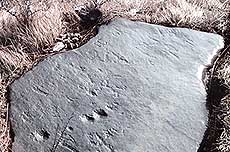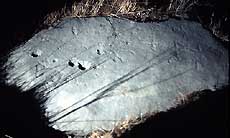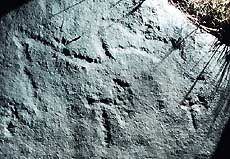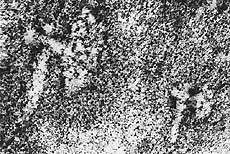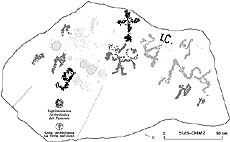|
|
 |
 |
Country: |
Italia |
Locality: |
Mompantero - Chiamberlando |
|
 |
Region: |
Piemonte |
Area: |
Valsusa |
|
 |
 |
|
|
|
|
| |
 |
Environment & Surface |
 |
 |
 |
|
Altitude:
|
1140 m
Open-air
Shelter
Cave
Portable
Megalithic
|
Geography: |
Glacial shoulder on rocky slope, southward exposed, panoramic site, abandoned sheep pasture, xerophilous vegetation (Juniperus, little pine-tree), arid and windy area. |
Proximity: |
|
|
 |
Geology: |
Filladic calcschist (metamorphic rock composed by calcite and mica). This kind of rock allows the pecking technique, but is more affected by the erosion (water and wind) than the Permian sandstone, thus the siliceous component, not soluble in water, is quite resistant. |
Surface: |
Smooth, microgranulated, flat, 12-15° of inclination, patina |
|
Dimensions:
|
Length 2.00 m.
Width 1.10 m.
|
|
 |
 |
|
|
|
|
| |
 |
Art |
 |
 |
 |
Description: |
Engravings
Paintings
Painted engravings
High or low-relief
Sculpture
Axes are disposed in couples, always with a larger one, like a battle axes-set. The shape of the blade clearly recall the late Iron Age Ornavasso kind axes. The anthropomorphic figure is quite uncertain, possibly holding a shield. The Latin cross and the letter are less patinated. Cup-marks have not been polished.
|
Figures: |
total number 23
4 axes with half-moon shaped blade, 1 anthropomorphic figure, 4 aligned cup-marks, 3 meanders, 1 Latin cross, 3 letters, 2 unidentified "objects", 5 groups or sparse pecking
|
|
 |
Chronology: |
Palaeolithic
Epipalaeolithic - Mesolithic
Neolithic
Copper Age
Bronze Age
Iron Age
Roman
Middle Age
Modern
Unknown
The axes are very similar to the late Iron Age axes of Ornavasso (I cent. BC - I cent. AD, in this period the Valsusa area was occupied by the Celtic people called "Segusii", after the 9 AC the Romans). It is also possible to compare the half-moon shape of the blade with the corresponding Iron Age halberd-axes engraved in Valcamonica (late Iron Age). The meandering subject is a problematic one to be dated. It's possible to find a double chronological attribution: Neolithic-first Copper Age (by comparison with the meanders and the spirals of the Irish passage graves and of the megalithic art) or Bronze Age - First Iron Age (by comparison with the engravings of the Haute Maurienne French valley where such patterns seem to be related to the Iron Age topographical compositions). The study of the superimpositions in the Valsusa area testify that the meandro-spiralic pattern is overlapped by late Iron Age figures, like the axes of this rocks which clearly cut the meanders.
|
Notes: |
The rock was dug during the '90s all around the border without finding any new figure. Firstly noticed on 1992 by Andrea Arcà. |
|
 |
 |
|
| |
 |
Bibliography |
 |
|
|
|
|
| |
 |
Conservation |
 |
 |
 |
Status: |
Public
Private
Park
Classified site
|
Risk: |
Figures are visible only on a grazing light. The site is poorly attended. |
|
 |
Conservation: |
Good
Quite good
Mediocre
Bad
|
Intervention: |
The rock has been completely recorded (International western Alps rock art record), traced (contact tracing and digital vectorial rendition), photographed (normal light and grazing light colour slides) under enchargement of the Archaeological Superintendence of Piedmont. More info (Italian version) at http://rupestre.net/archiv and http://rupestre.net/alps. |
|
 |
 |
|
|
 |
By |
 |
|
| |
| Record n. 501 / 807 |
No commercial use is allowed. Specific © is mentioned in the captions or owned by each Author or Institution |
|
| |
 |
EuroPreArt, European Prehistoric Art, is a web-based archaeological project funded by the European Union which aims to establish a lasting data-base of European prehistoric art documentation, to launch the base of an European institutional network and to contribute to the awareness of the diversity and richness of European Prehistoric Art.
It is proposed by: Instituto Politécnico de Tomar (IPT, Portugal),
CUEBC - European University Centre for Cultural Heritage (Italy - Europe),
Consejo Superior de Investigaciones Científicas (España),
Asociación Cultural Colectivo Barbaón (España),
Université de Liège (Belgique),
Gotland University College (Sverige),
University College Dublin (Eire),
Cooperativa Archeologica Le Orme dell'Uomo (Italia),
Study Centre and Museum of Prehistoric Art of
Pinerolo (Italia),
The European Centre for Prehistoric Research in the Alto Ribatejo (Portugal),
ArqueoJovem - a youth NGO (Portugal).
|
|
|
|
 |
|
 NEW: Alpine rock paintings
NEW: Alpine rock paintings